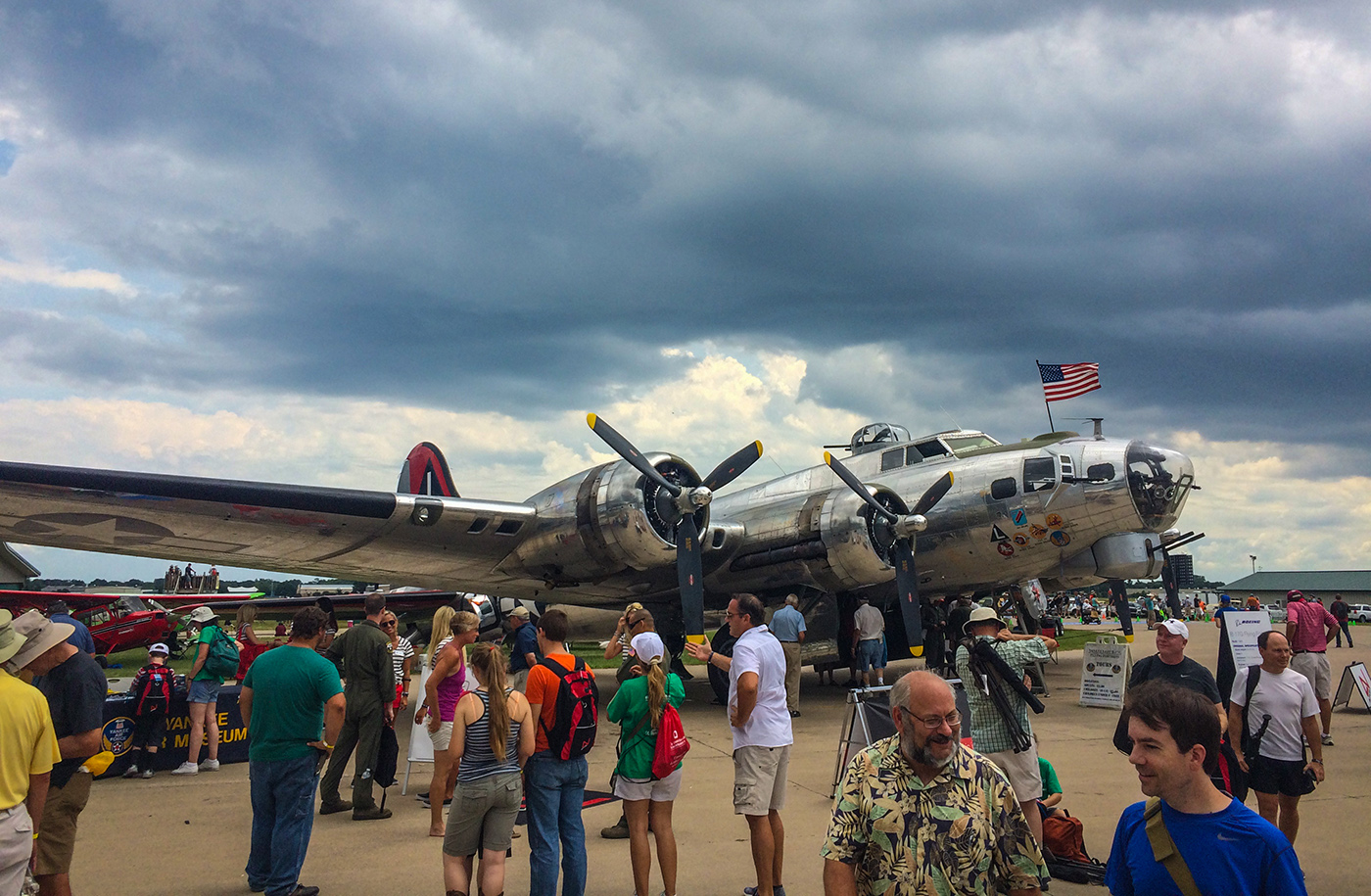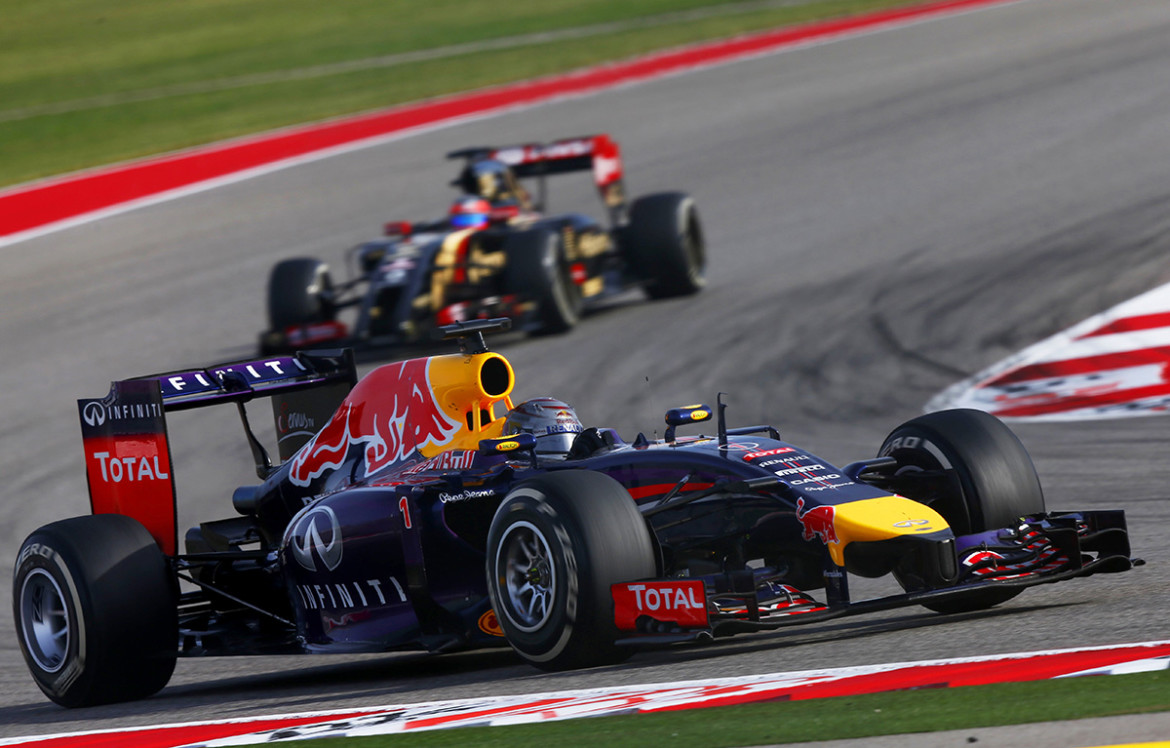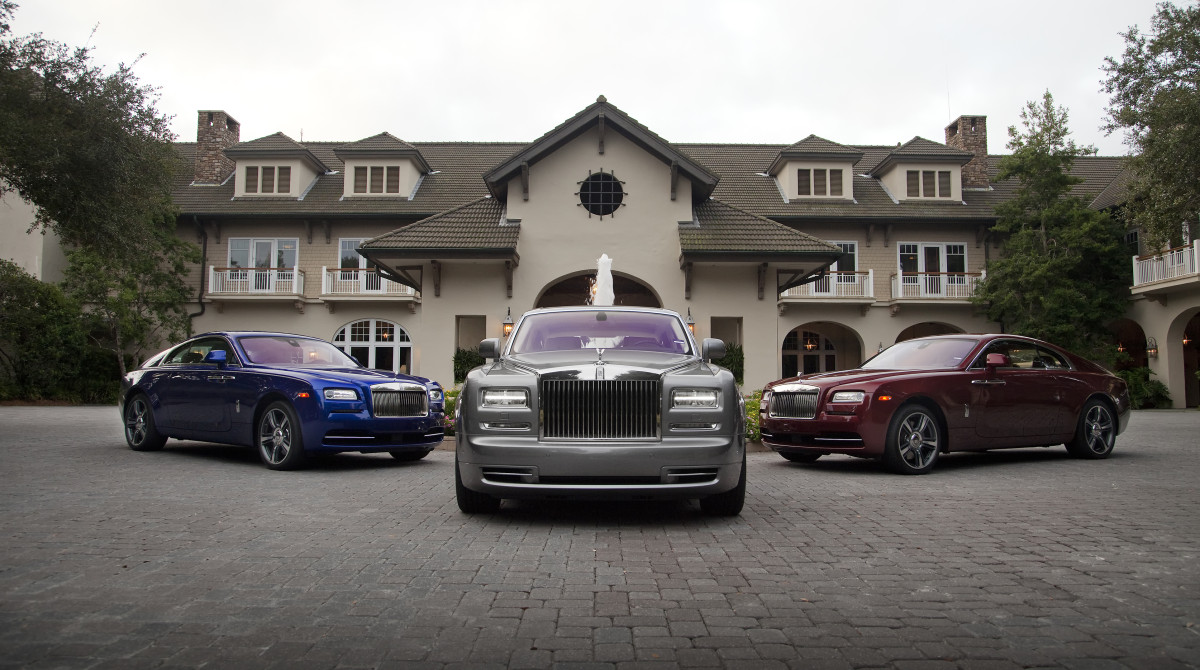Road Trip: Following Dead & Company Down The Coast In A Toyota Highlander
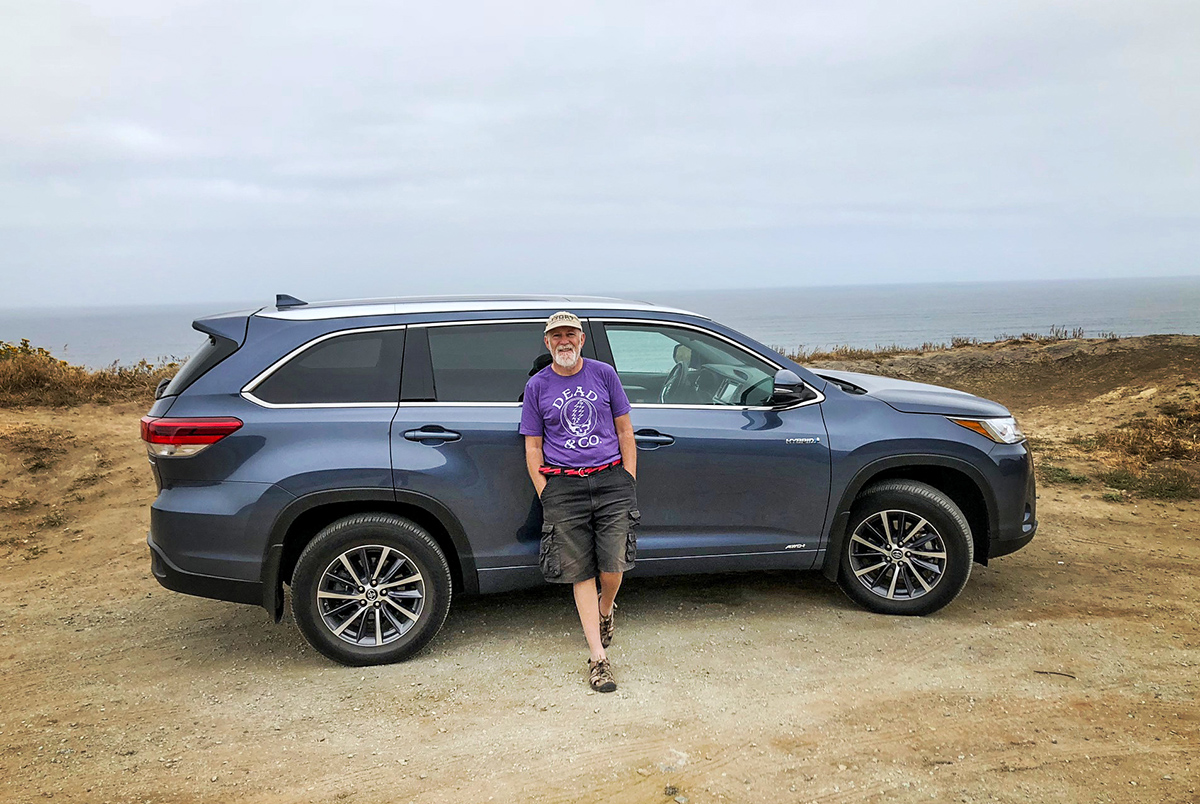
Following the Grateful Dead on tour, the late Jerry Garcia observed, was the archetypal American adventure, the modern equivalent of joining the circus or riding freight trains. “You’re either on the bus or off the bus,” they say, and I’ve travelled by train, plane and automobile – and a bus or two — ever since April, 1971, when I drove in a 1970 Pinto to the first of about 75 Dead shows I’ve seen.
I’ve never had as sweet a ride, however, as the 2017 Toyota Highlander Hybrid SUV I drove for a week from Seattle to San Francisco for four shows by Dead & Company, the excellent band fronted by Dead co-founder Bob Weir and featuring Dead drummers Bill Kreutzmann and Mickey Hart and three outstanding younger musicians — guitarist John Mayer, bassist Oteil Burbridge, and Jeff Chimenti on keyboards. A generation after Garcia’s death in 1995, Deadheads of all ages are still filling pavilions and stadiums to be with the music, the musicians, and each other; as Weir still sings in a song from 1979, “if this ain’t the real thing, then it’s close enough to pretend.”
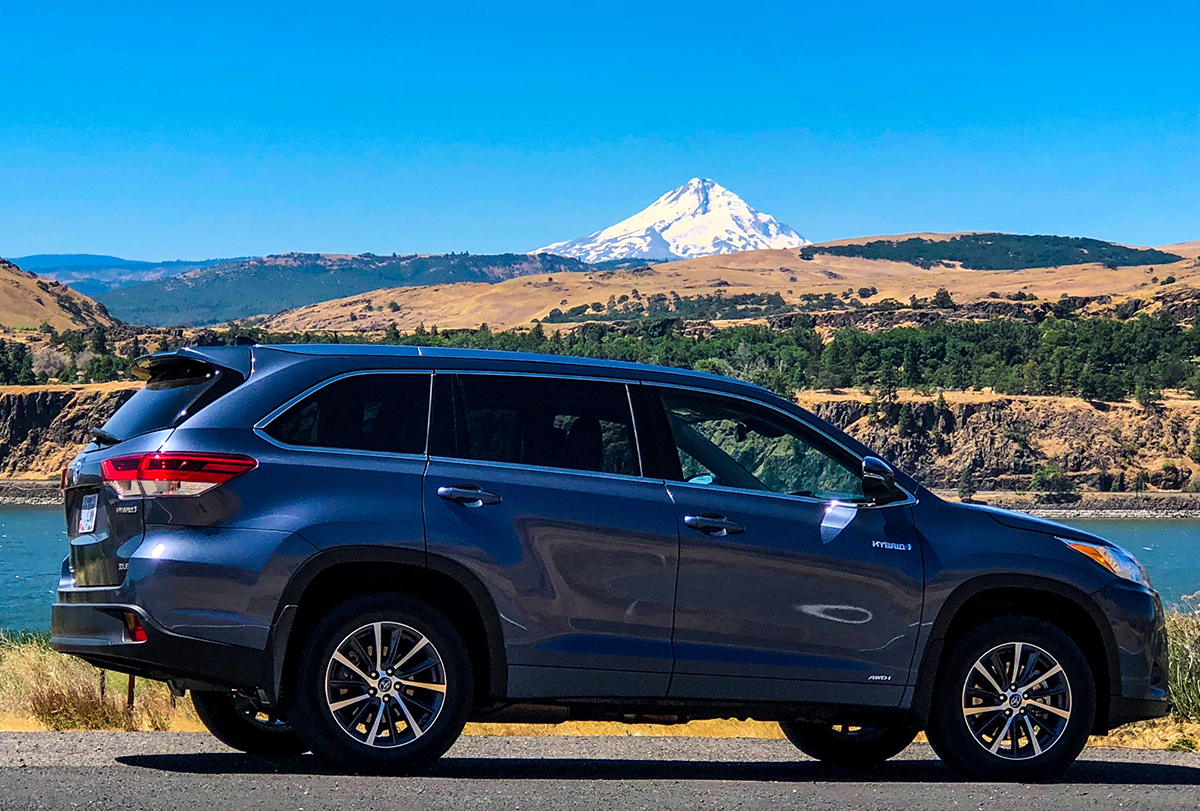
I’ve also never had as sweet an itinerary. I’ve lived 40 years in Madison, Wisconsin, where my world is a city of 250,000 in a region of rolling farmland; It was exhilarating to drive historic highways in the world of Puget Sound, the Columbia River, San Francisco Bay, Snoqualmie Pass, and both the Cascade and Siskiyou Mountain Ranges. Being in Seattle and San Francisco was nice, too.
All the previous Grateful Dead shows I’d been to were in the Midwest and East Coast; I’ve seen various Dead-descendant bands in the Bay Area since 1995, but this was my first extended run on the West Coast, first extended exposure to West Coast Deadheads. I figured they’d be more mellow and healthy than my usual crowds, and they were.
I’m a Deadhead, not a gearhead, so I can’t give an expert analysis of how the Highlander’s direct injection 3.5-liter V-6 engine with a continuously variable transmission combine with the two electric motors up front and a third for the rear wheels for 306 horsepower, or really explain how the regenerative brakes work. But on the things that mattered to me – especially highway power, maneuverability, and physical comfort – this SUV was AOK.
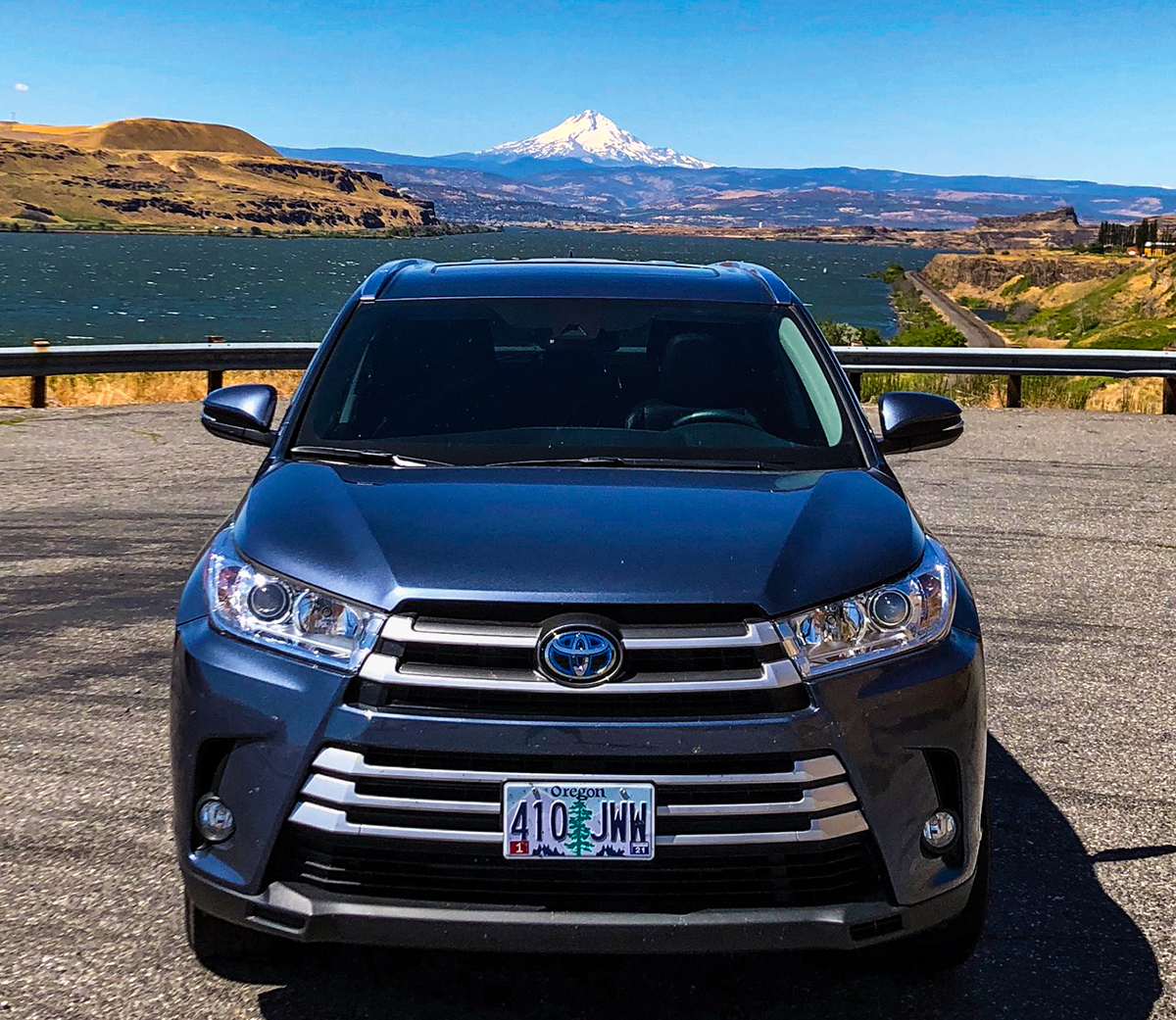
Once I figured out how to start it. The electronic direct ignition system and hybrid powertrain were so smooth and silent, I had turned the car on without realizing it.
Like I said, not a gearhead.
Since my final two shows would be at the Shoreline Amphitheater in Mountain View, California, and the Grateful Dead song Bird Song is about a woman – Janis Joplin — nicknamed “Pearl,” it was a nice coincidence that of the nine exterior colors available, the XLE the Toyota folks provided Wednesday morning was in Shoreline Blue Pearl. So “Pearl” the Highlander Hybrid would be.
The late rock impresario Bill Graham famously said of the Dead, “they’re not just the best at what they do, they’re the only ones who do what they do.” What they did from 1965 to 1995 was combine every form of popular American music – bluegrass and blues, bebop and ballads, folk, country and western, rock and roll (even a little disco) and feedback – to a degree no other band could match. Marinated, in the early days, in LSD, they developed a level of group improvisation equal to the best jazz sextets. Their songs had profound meaning and brilliant imagery, thanks to two of the best lyricists this side of Bob Dylan, Robert Hunter and John Perry Barlow. “A band beyond description,” they sang of themselves in The Music Never Stopped, “like Jehovah’s favorite choir.”
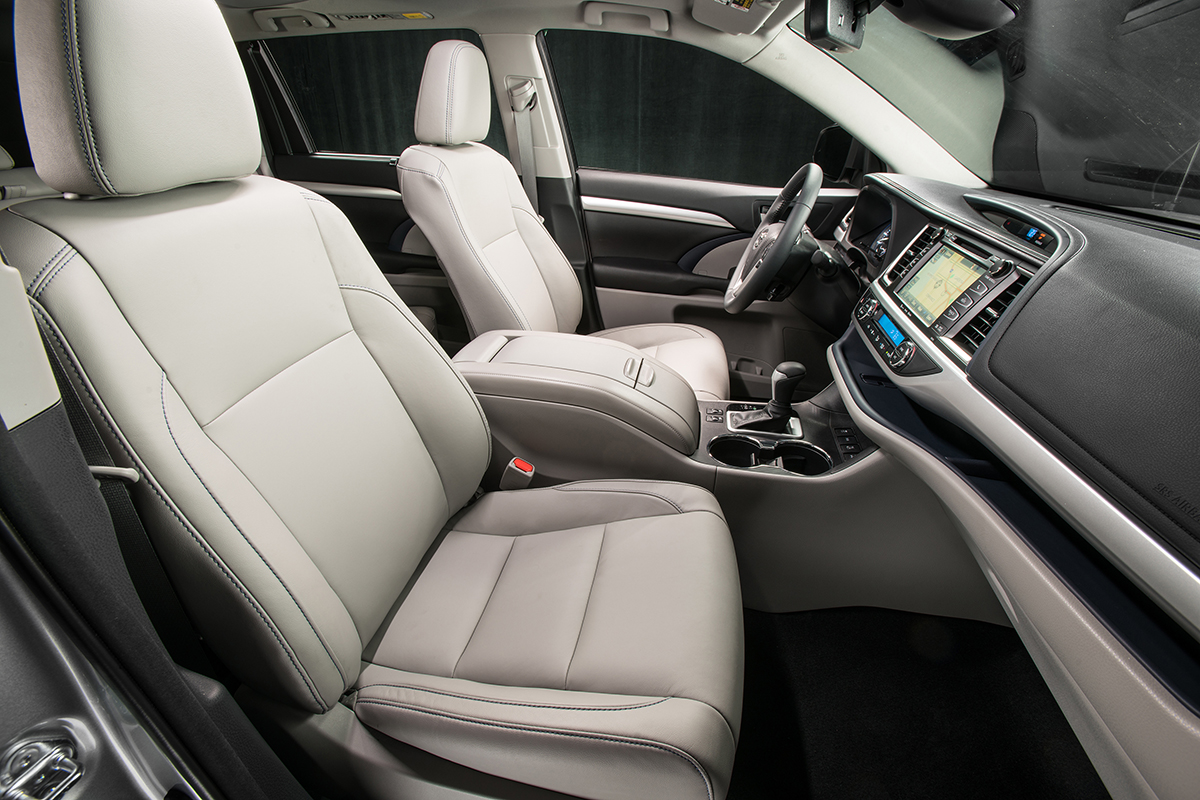
Graham’s adage could be adapted for the Highlander Hybrid – not just the best hybrid-powered three-row crossover, but the only hybrid-powered three-row crossover. The XLE was the highest of three new mid-range trim levels, with three existing levels above, when it was introduced in 2017, and first impressions left me impressed. Its tasteful appointments included leather, leatherette and Soft-touch trim, an 8.1-inch touchscreen, a 4.2-inch color LCD multi-information display, second-row retractable window sunshades, and a rear-seat BluRay DVD system with 9-inch display — an appealing $1,810 add-on if you’ve got passengers you need to keep entertained (although it seemingly presents a potential safety hazard by blocking the driver’s view through the rear-view mirror when in use).
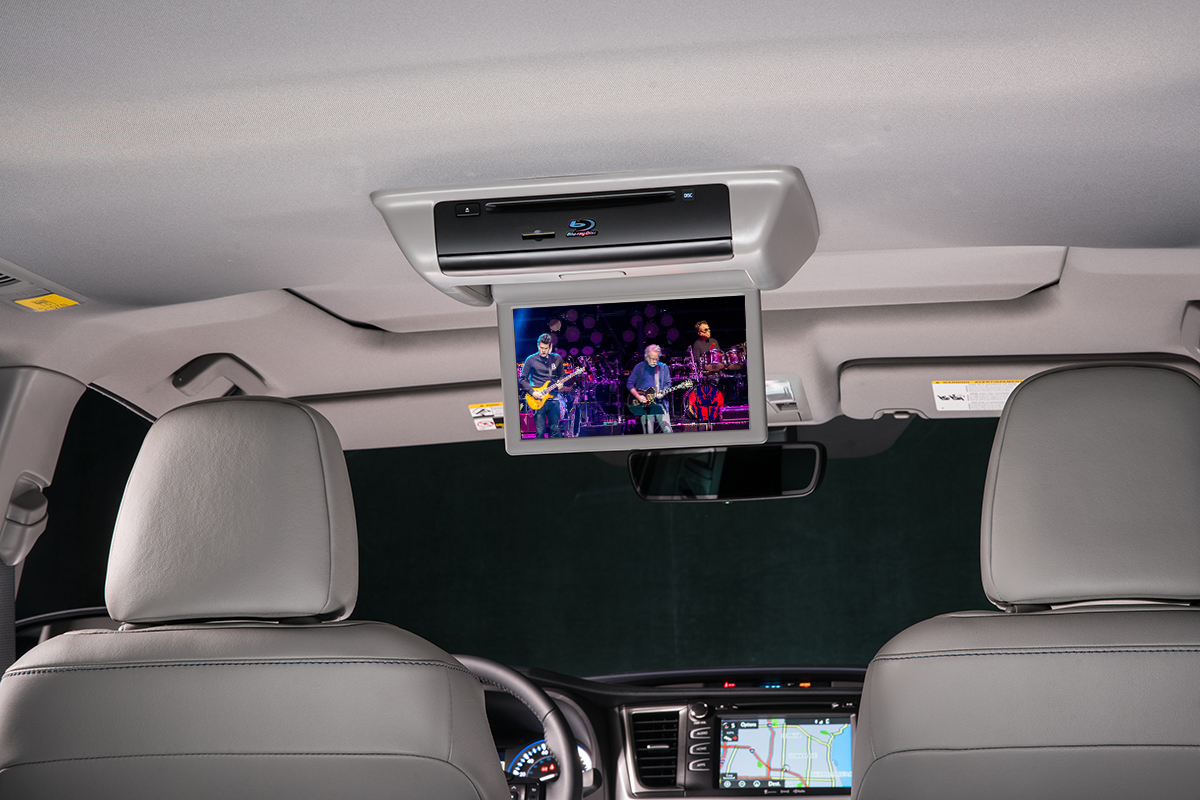
It’s easy to see why the Highlander Hybrid has an overall vehicle safety score of five stars; the Toyota Safety Sense P is now standard across all trim levels. In addition to the eight airbags, TSS-P provides automatic emergency braking, lane departure warning with steering assist, and automatic high beams. But my favorite was the dynamic radar cruise control, which smoothly lowered and raised the cruising speed to match the speed changes and location of the vehicle ahead of me. It could even brake if a much slower car pulled into my highway lane (which did happen). There’s also forward collision warning with pedestrian detection, but I don’t know how well that works because I complied with the manual’s mandate: “Do not attempt to test the operation of the pre-collision system.”
It didn’t affect my storage needs, but the cargo scorecard is mixed. With only 13.8 cubic feet behind the third row, the Highlander Hybrid is well short of the storage capability of the Honda Pilot and Ford Explorer. But the third row folds down easily, giving a respectable 42.3 cubic feet. And there are four nifty features: a flip-up rear window in the power liftgate, an underfloor storage bin to hide and organize small items, a ginormous front seat arm rest/storage bin seemingly big enough for two gallons of milk, and an extensive shelf running the length of the dashboard, complete with pass-through portals to connect electronics to the three USB ports (the second row has another two USB ports, and there are also two 12V auxiliary power outlets and one 120 auxiliary AC power outlet).
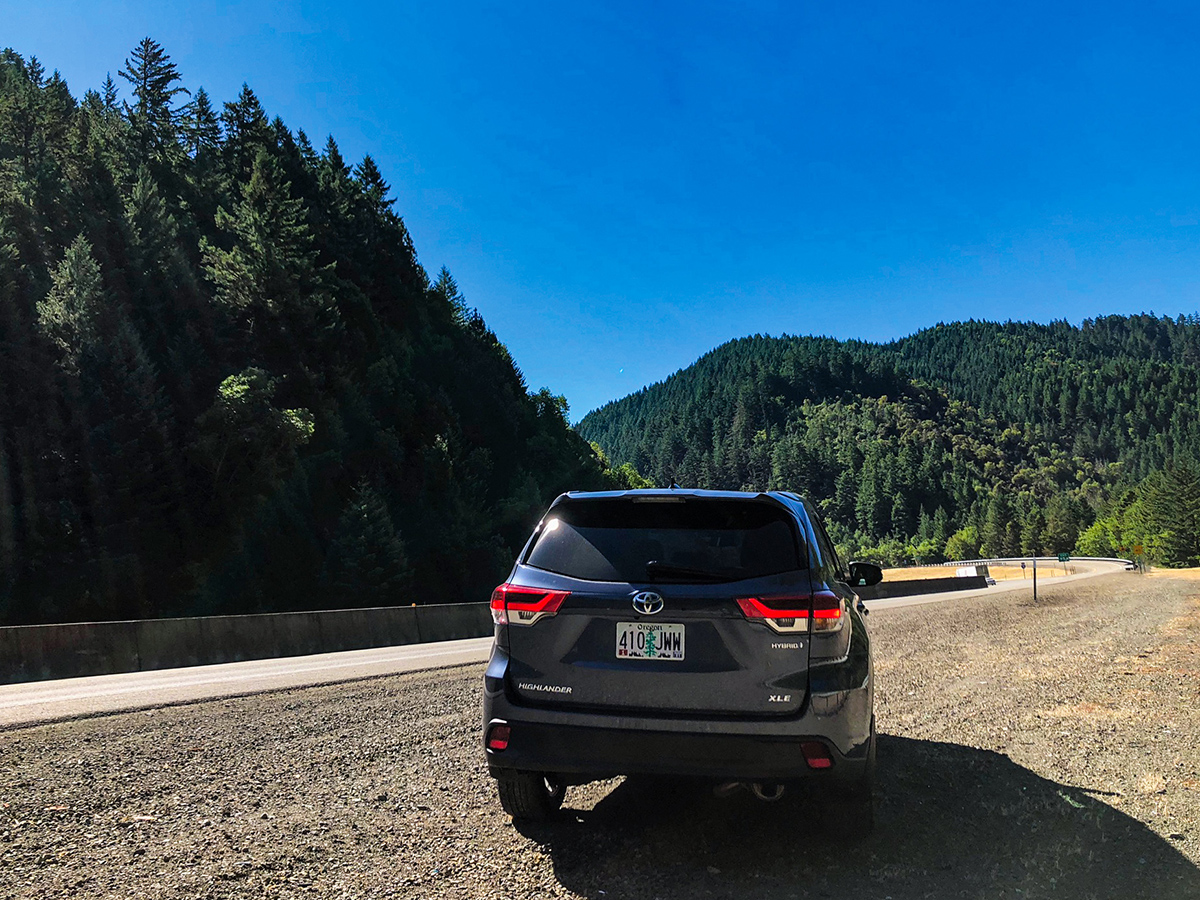
The new, more affordable trim lines lessen, but don’t eliminate, the added cost for going hybrid. But with the hybrid’s increase in fuel efficiency modest but real – about 5 mpg combined city and highway – and gas prices rising, the economic calculus is shifting towards the new technology. Beyond the personal economic return, the hybrid has the meaningful public benefit of reducing emissions and noise.
For some, the most interesting XLE feature will be Driver Easy Speak, which uses a microphone in the overhead console to amplify the driver’s voice and broadcast it through rear speakers. It’s probably intended to help the driver keep children in line, but also lets you do some harmony singing or late night poetry readings, if you’re so inclined.
One of the benefits of touring is the opportunity it provides to reconnect with family and friends. So it was that I headed first for the Olympic Peninsula, to see my cousin Philip and his family in Port Townsend, where he is the Jefferson County administrator. On the winding two-lane roads skirting the Olympic National Park and Forest, with a tree canopy so thick it blocked the satellite radio, the Highlander passed its first test of drivability. Well, maybe the warning bell sounded once or twice, but that didn’t affect the handling. Unsurprisingly, that night I had the best salmon I’ve ever eaten, bayside at Doc’s Marina Grill.
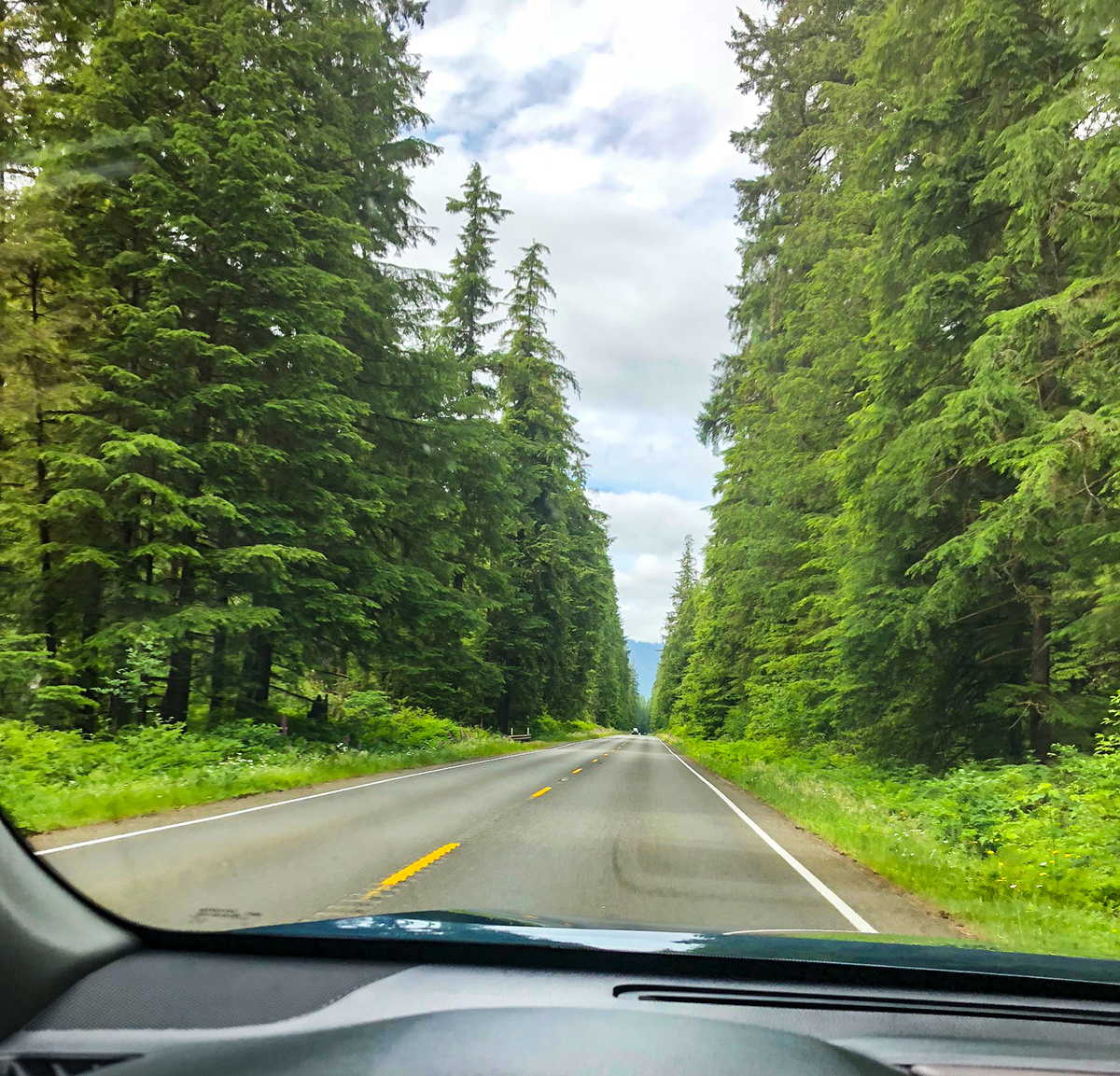
Thursday morning, we went back in time. As chairman of the Madison Landmarks Commission, and author of two books about Madison’s history, I’m always up for learning about another city’s history, and there’s plenty in Port Townsend, including cinematic. First, a walk through the abandoned artillery emplacements at Fort Worden, built to protect Puget Sound around the turn of the last century; site of the filming of An Officer and a Gentleman, it’s now on the National Register of Historic Places. Then a tour of the Port Townsend Historic District, a National Historic Landmark District thanks to its well-preserved Victorian and Richardson Romanesque architecture. After some more bayside salmon, I pointed Pearl south and headed to Bainbridge Island to catch the 4:45 ferry to Seattle. It’s a lovely drive, but growing concern about missing the boat limited my full enjoyment of it. I got dockside with a few minutes to spare, the last to board.
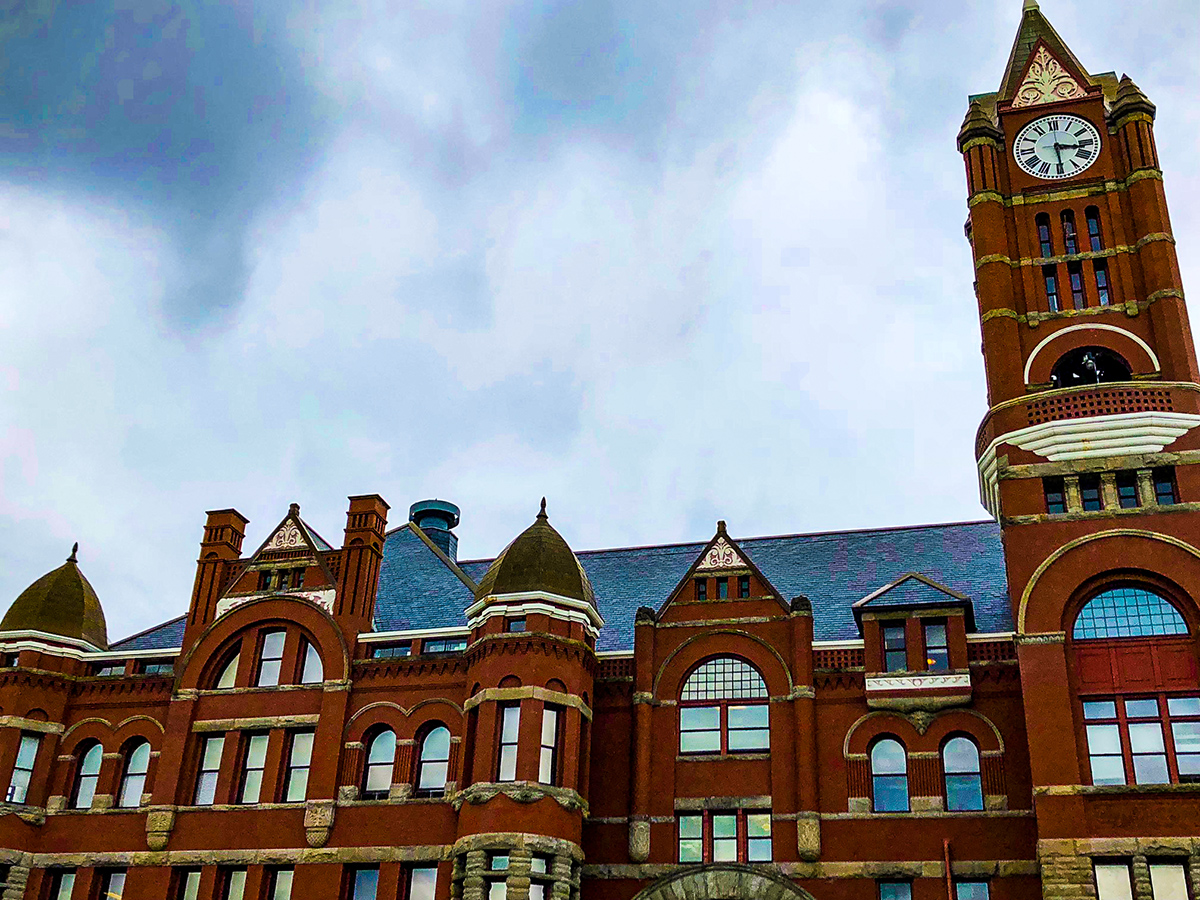
Driving into and out of Seattle was no fun. Construction, streets at strange angles, and the Monorail columns combined for a stressful and harrowing experience. Especially since I was driving the largest vehicle I’ve ever driven, and a loaner at that. Thankfully, Pearl’s 38.7-foot turning radius was good enough to pull a mid-block U-turn and slide into the Belltown Inn’s single loading spot.
The hip, contemporary hotel met two transportation needs – a parking lot just up the block (final item on the agreement with Toyota: “UNDER NO CIRCUMSTANCES is the vehicle to be parked in the street.”) and a loaner bicycle (with helmet, light and lock). All the desk personnel were friendly and helpful, with a noticeably easier time providing directions to the nearest marijuana dispensary (2 blocks away) than to a liquor store (I ended up getting my vodka at the CVS. Yeah, I prefer a nightcap relaxing in my room to drinking in a bar – you got a problem with that?)
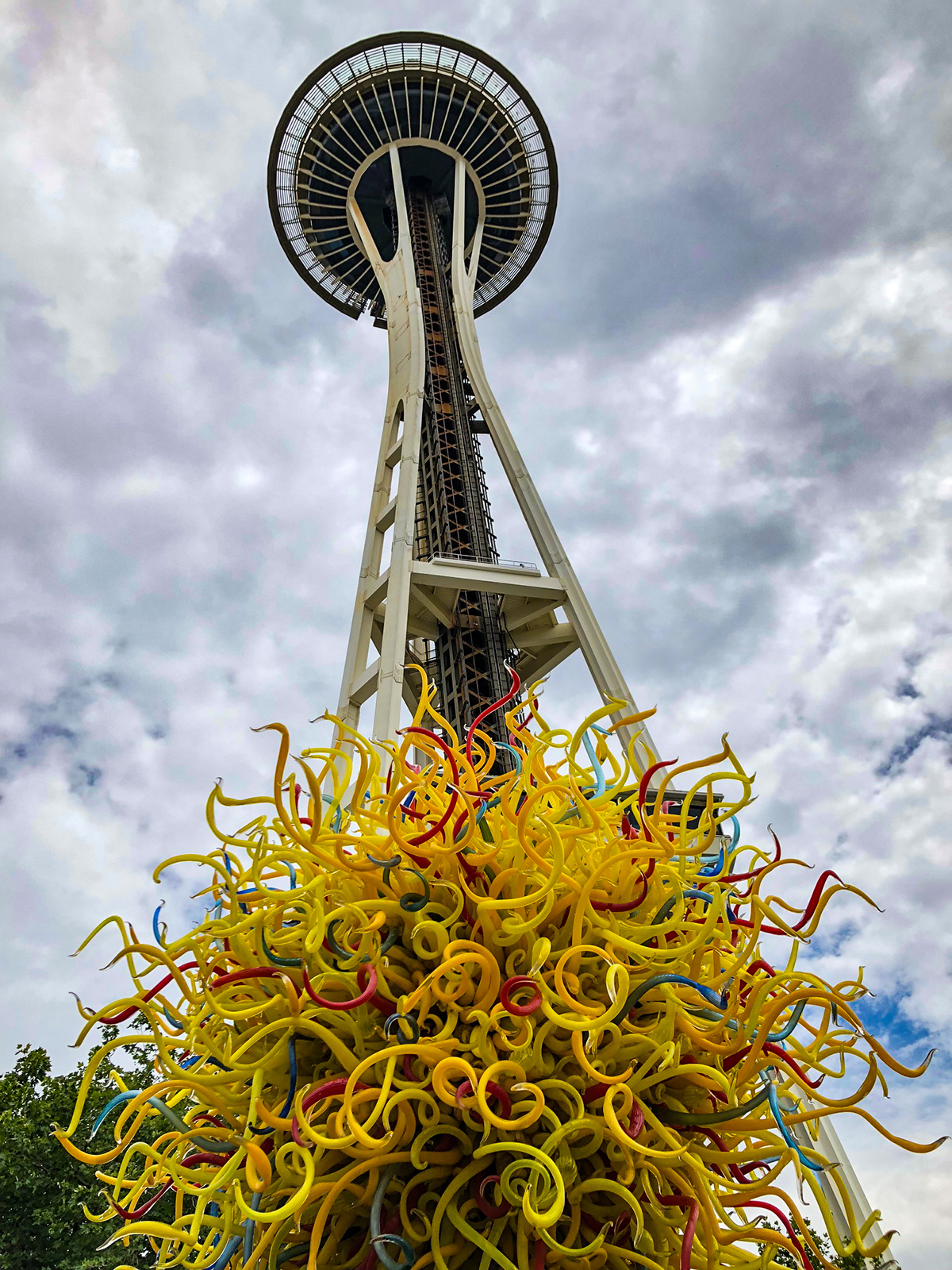
Another benefit of touring is … being a tourist. Checked-in and refreshed, I bicycled the eight blocks to the Seattle Center, CityPass in hand, for sunset atop the under-renovation Space Needle. It has not only breathtaking views through the new glass panels but about the best gift shop I’ve ever seen. Friday morning, I biked back there to ride the Monorail and visit the Museum of Pop Culture and the Chihuly museum and garden (the glass genius was a University of Wisconsin graduate student/teaching assistant in 1967).
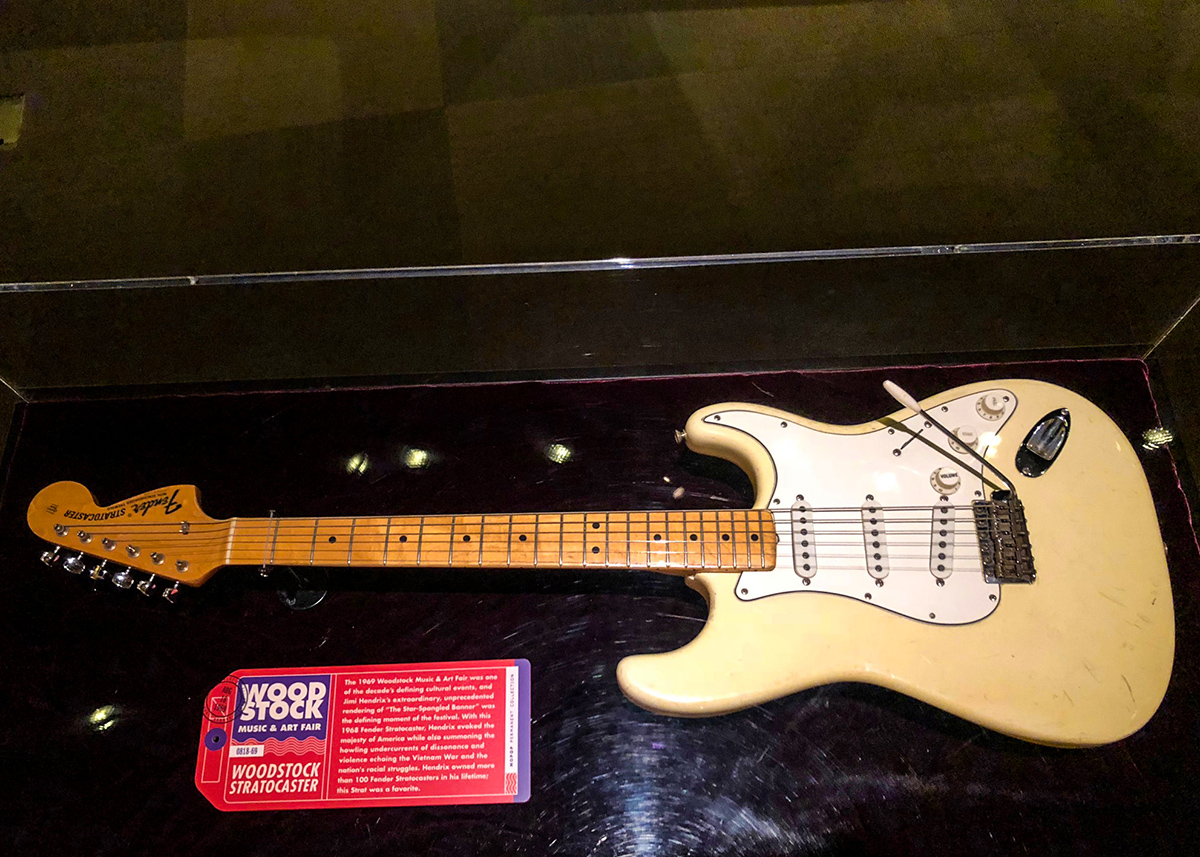
Then I left in plenty of time for the 7 pm show at the gorgeous Gorge Amphitheater on the banks of the Columbia River, about 150 highway miles east in George, Washington.
Or so I thought. I had know idea Seattle had become the city of both urban and mountain traffic jams.
According to Mapquest, the drive should take about 2:12. Leaving the hotel, it took me 45 minutes to go the last three blocks to the highway; that’s when Pearl’s Stop and Start Engine System, which automatically shuts off the engine to save fuel and the environment, proved so useful. I finally merged onto I-90 at its beginning, in the shadow of Safeco Field, thinking that 3,020 miles east, someone was exiting at its terminus in downtown Boston, just past Fenway Park.
Then, a half-hour down the road, a digital sign bore the odd information that Ellensburg was 76 miles away, and would take 176 minutes to get there. Surely, a digital typo.
Nope. Snoqualmie Pass and its highway construction project about tripled the time of normal highway driving. But what views I had as we crawled along! Steep cliffs of deep forest, rimmed by clouds. It was chill – I was on tour and in a comfortable vehicle.
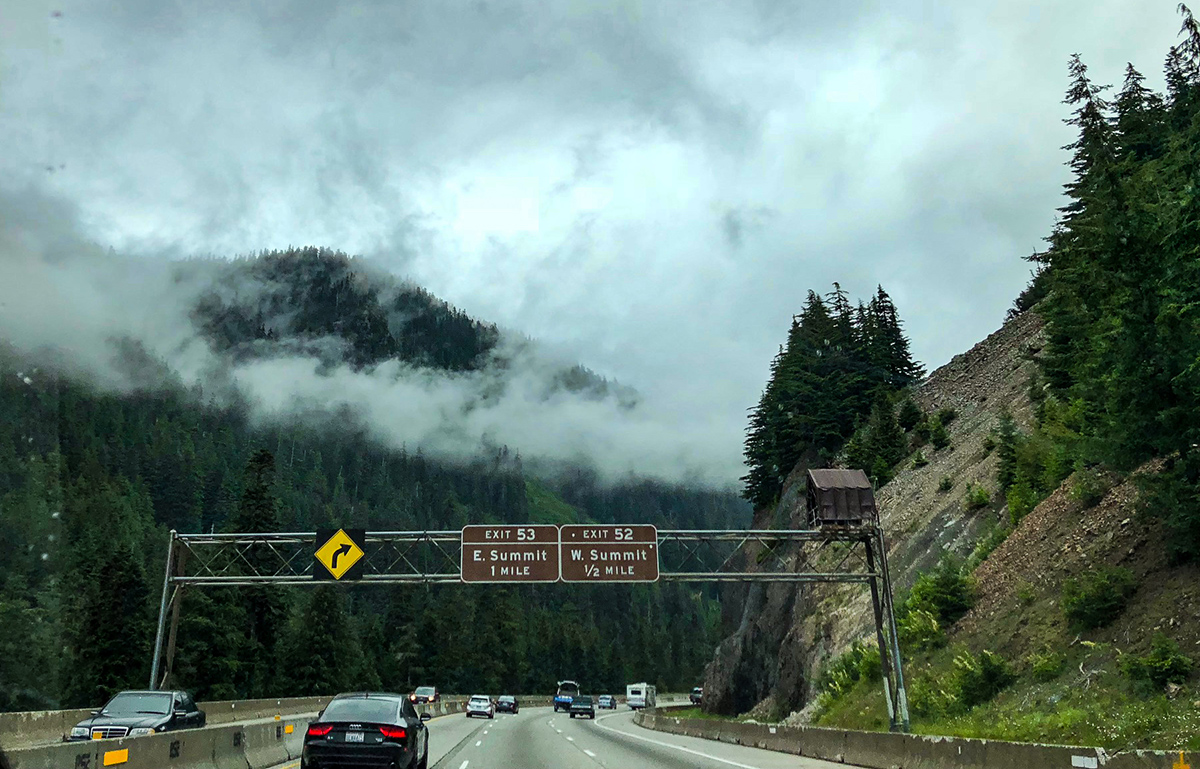
Hang a left at Ellensburg, and a little past Kittitas, suddenly it’s a new, seemingly prehistoric world – the hard and barren landscape of the Gingo Petrified Forest State Park, the riverfront backdrop for the Gorge. Also, a new, sunnier climate.
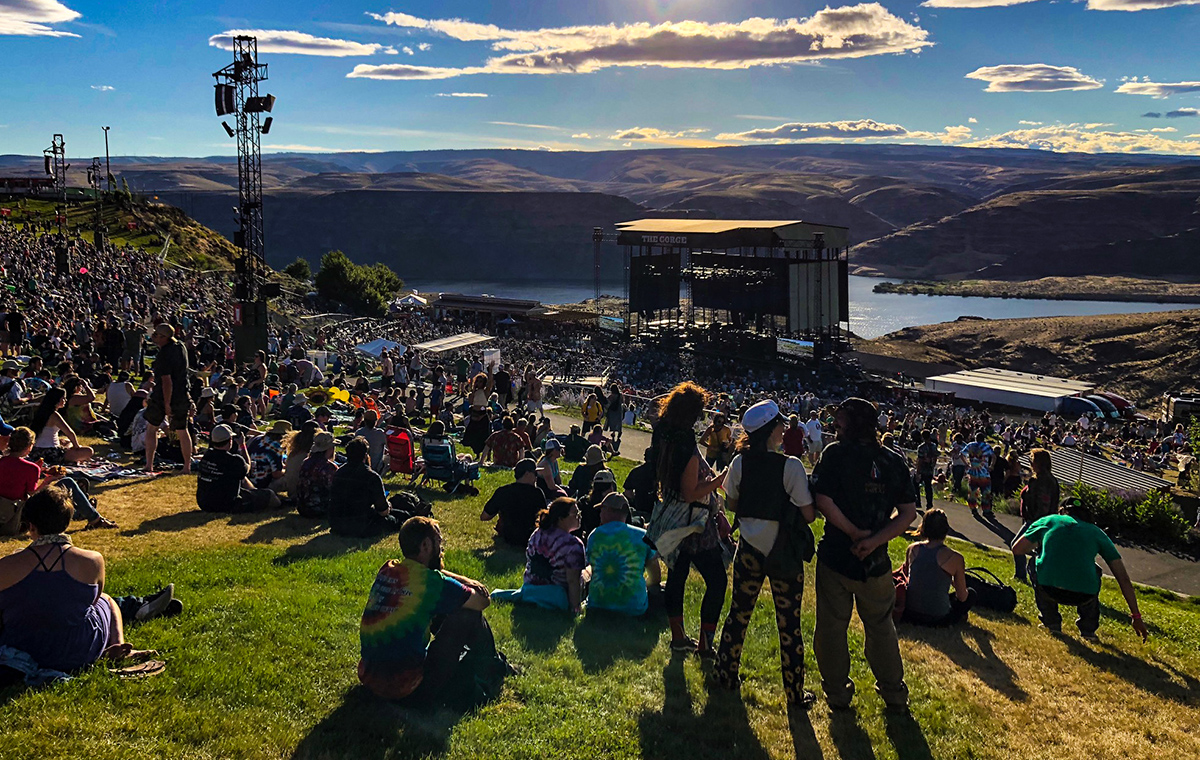
The vagaries of location and surroundings materially affect appreciation of a show, and I scored on both – way down front, amidst happy people who didn’t talk while the music was playing (I no longer have to worry about tobacco smokers, especially in California). The band, fresh from a five-day break in the summer tour – their last two shows had been on my home field, Alpine Valley – did its part with a bubbly show that drew heavily on songs from my favorite era, the early seventies.
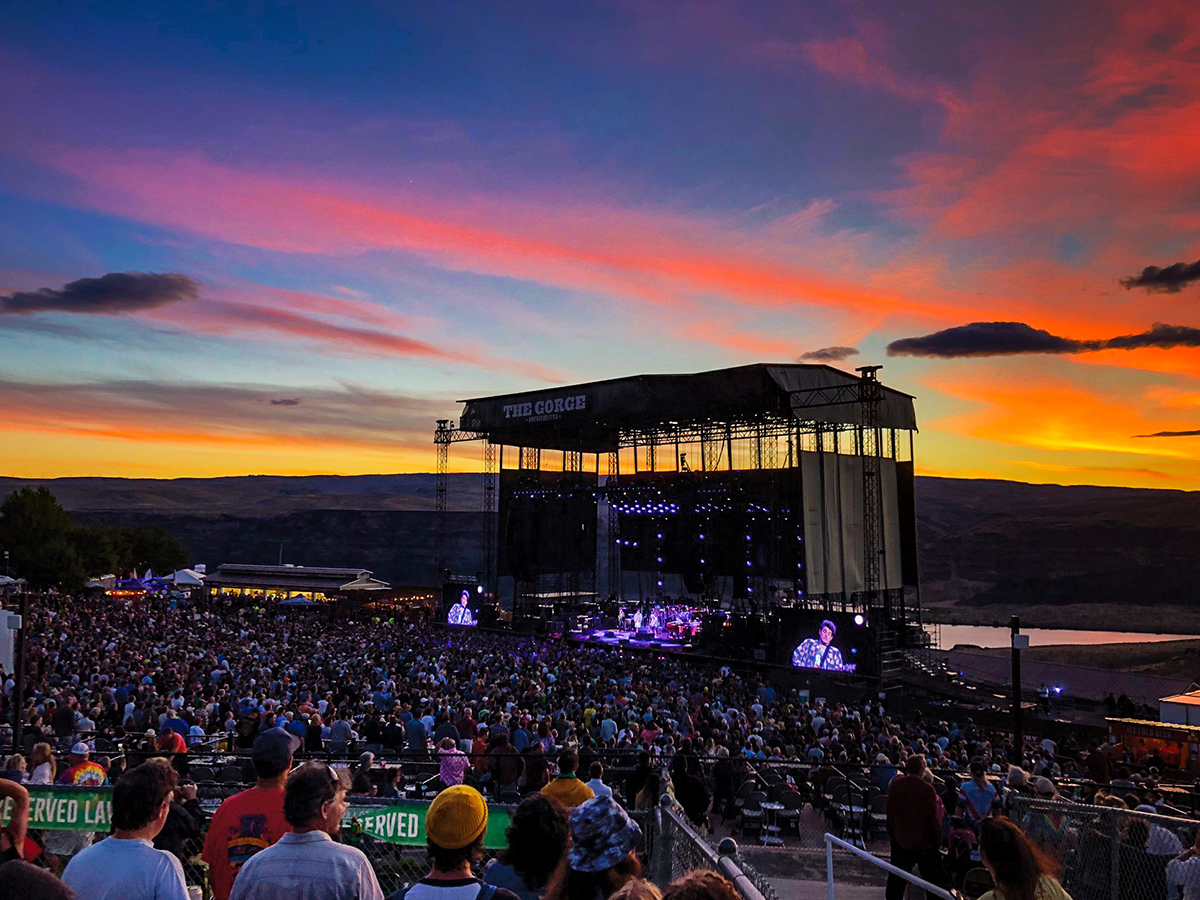
One of the psychic values of seeing a band over decades is how certain songs trigger musical and personal memories from across the years. As Dead and Company began their first-ever version of “Mr. Charlie,” a funky tale of shotguns and alligator wine, I immediately flashed to being in the Yale Bowl on July 31, 1971, when the Grateful Dead performed it for the first time. The two Stu’s – teenager and senior citizen – greeted each other warmly, then settled into the music, which peaked with the 15-minute “Playing in the Band,” and its show-closing reprise.
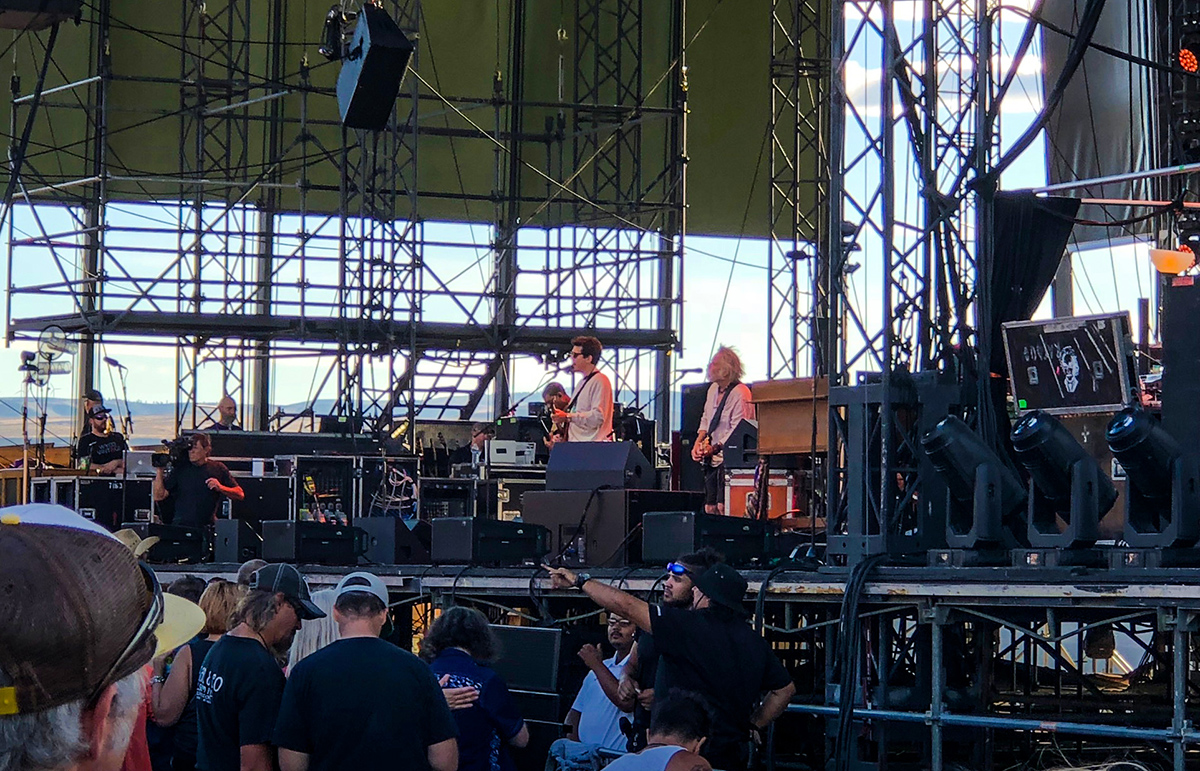
The drawback to great seats, of course, is that you’re among the last out. With only a single two-lane road back to the highway, being on the wrong side of this crowd would cost me hours; it had already been a long and eventful day, so I made my goodbyes before the band came out for the encore, which I caught sitting on the lawn up top before quick-stepping it to Pearl. I made it to the Deadhead-filled Knight’s Inn in Quincy in twenty minutes.
Everyone was up and out Saturday morning; Eugene was 375 miles away, a good six and a half hours of mountains, forests and rivers.
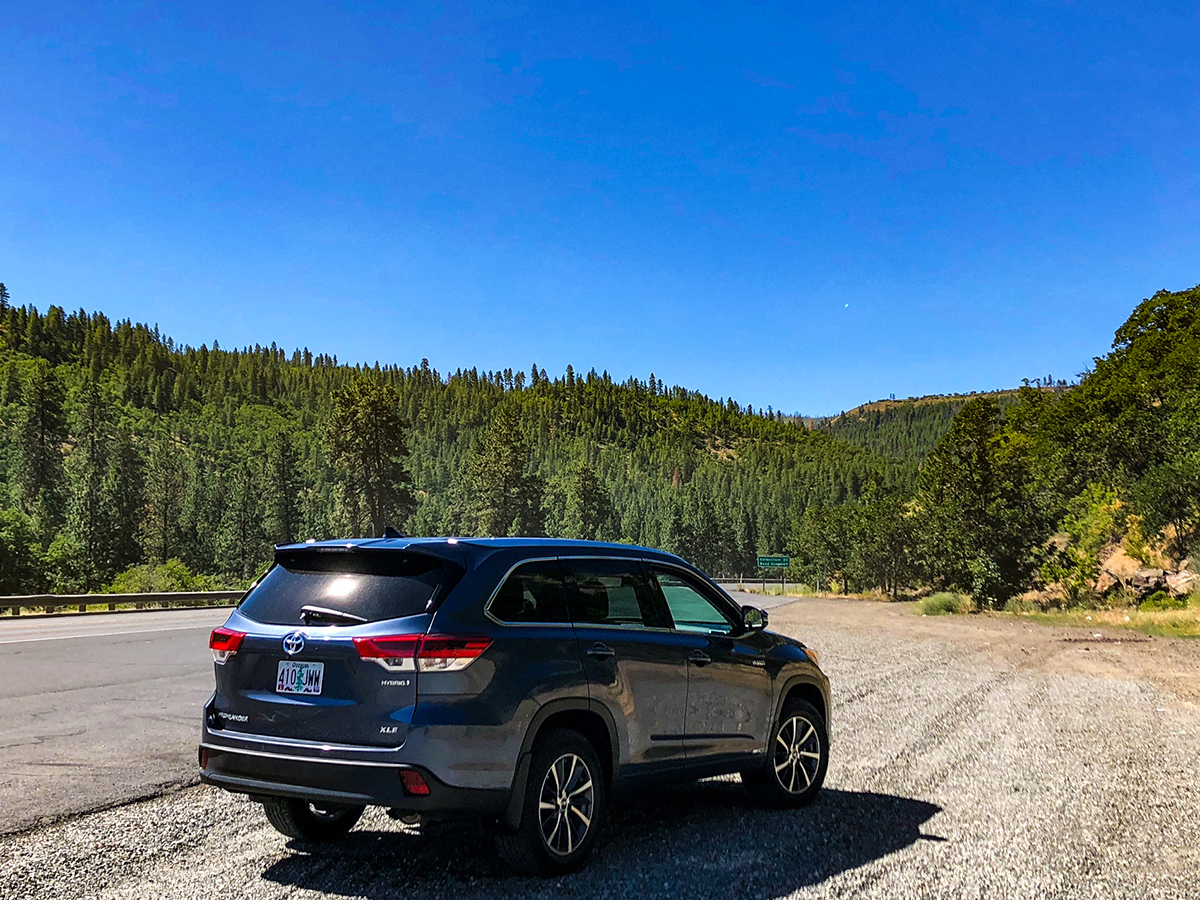
Through the Yakima Indian Reservation, past the Gifford Pinchot National Wilderness, highway, I met history again when I crossed the Columbia into Oregon over the steel truss cantilevered Bridge of the Gods and got on I-84. The steel bridge was named after a land bridge caused by a 15th-century landslide that figures heavily in regional Native American creation lore. The interstate, running along the southern bank of the Columbia, passing the Bonneville Dam on the way to Portland, is on my short-list for most scenic interstate highway in the lower 48.
As I-84 ends just east of Portland and I swing south on I-205 to rejoin I-5, I made the easy connection to Pearl’s audio system via Bluetooth to play a special selection – musician/radio host/author David Gans performing Jim Page’s Down to Eugene:
Pullin’ into town I’m all eyes and ears
Look at all these friends I ain’t seen all year
Tripped-out hippies, rag and bone
Young dot-com tie dye cellular phone
Delia DeLyon and Tennessee Jed
Are goin’ down to Eugene to see the Grateful Dead
The University Inn, just down from the University of Oregon, is awash with ‘heads, and the small parking lot is jammed. It’s here that the well-calibrated backup camera, with path guides, came in very handy guiding me into a tight spot.
Sometimes it’s reconnecting with friends not seen in a year, sometimes with friends not seen in four decades. That was the bonus delight tonight – bringing my boyhood chum Wayne, whom I hadn’t seen since about 1971, to the show.
And what a show it was, with a second set straight out of the late sixties. It opened with the holiest of holies, the interstellar exploration Dark Star, in which lyricist Robert Hunter cops a little T. S. Elliot:
Dark star crashes, pouring its light into ashes.
Reason tatters, the forces tear loose from the axis.
Searchlight casting for faults in the clouds of delusion.
Shall we go, you and I while we can
Through the transitive nightfall of diamonds?
Mirror shatters in formless reflections of matter.
Glass hand dissolving to ice petal flowers revolving.
Lady in velvet recedes in the nights of goodbye.
When you’re driving hundreds of miles at a clip – Eugene to San Francisco was about 525 – comfortable seats are a priority, and Pearl was a gem. I didn’t so much need the heat function for the leather-trimmed front seat – the thermometer hit triple digits that day – but the lumbar support and under-thigh extension on the eight-way power-adjustable driver’s seat proved invaluable.
A bit south of Medford, I passed out of the Rogue Valley and up into the Siskiyou Mountains, where the summit, at 4,310 feet, is the highest elevation on I-5. Pearl took the steep and winding highway in stride, but the 6 percent slope and frequently foggy conditions can be tough on the 13,000 daily truckers; there are escape ramps for when things get particularly dicey. And there’s history here, too; just to the west is Siskiyou Pass, first crossed by a Hudson Bay Company fur trader in 1827. They did it without the Entune Premium Audio with Integrated Navigation and App Suite that Pearl provided (alas, Apple CarPlay and Android Auto are not available yet, and some of the audio controls, while easy to use, are a bit of a stretch for the driver).
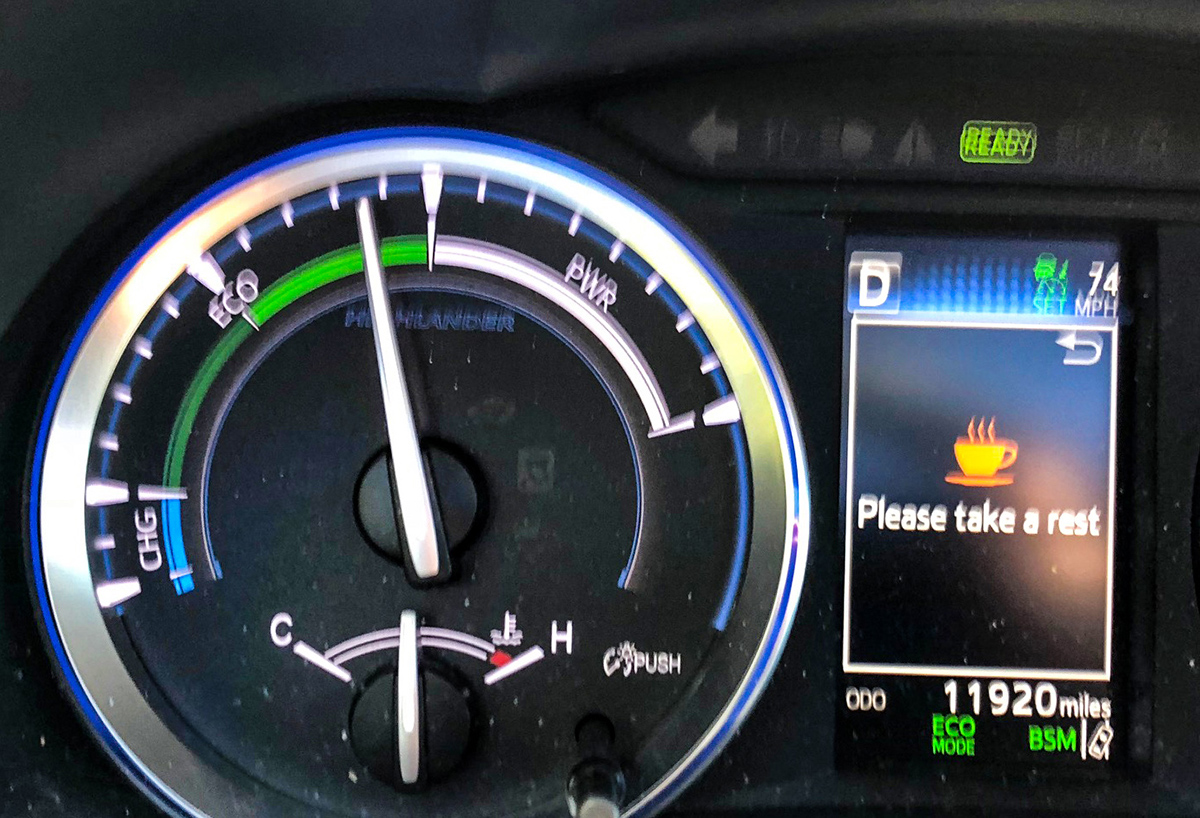
Down past Klamath Falls and into California, the greatest of the states, where all founding members of the Grateful Dead were born (the Bay Area, to be precise). “California, preaching on the burning shore,” Barlow wrote in his takedown of a messianic acid casualty, Estimated Prophet. “California, I’ll be knocking on the golden door.”
A place to drive with the top down, because “rainbows end down that highway where ocean breezes blow.” I had earlier hoped to take this journey in a convertible, but Pearl’s power tilt/slide moonroof was large enough and the windows were wide enough, that it felt like I was.
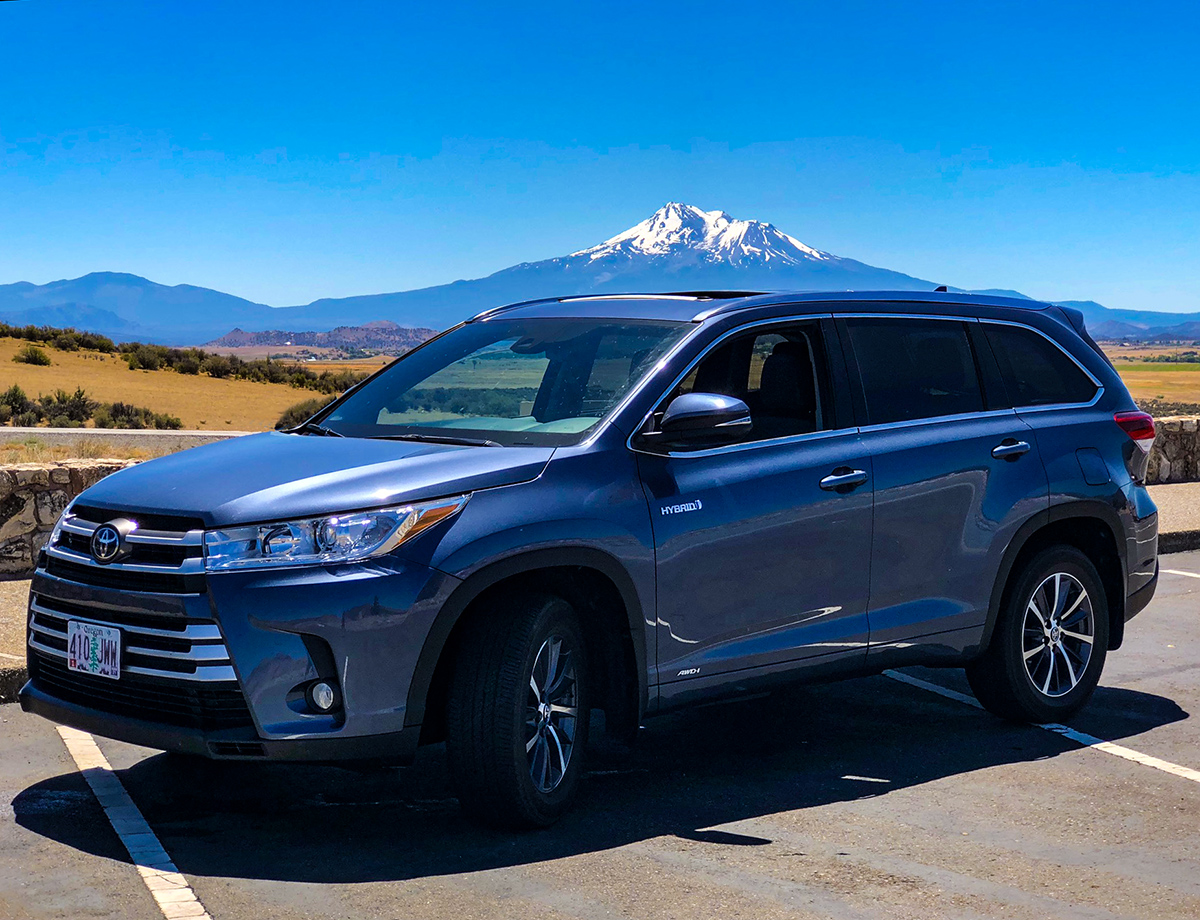
Sacramento Valley, past the city of Redding, and the lesson that not all breezes blow good tidings. In late July Redding and other cities were evacuated due to the wind-whipped Carr Fire, which burned 100,000 acres in its first week (and is still only partially contained).
Turning southwest off I-5 to the 505 and 80, I passed through a very sharp climate change – the outside temperature went from 104 to 65 in about 30 minutes. San Francisco was in my sights.
A shockingly affordable ($178) tenth-floor room at the historic Intercontinental Mark Hopkins brought back warm memories of a family stay here in 1967 (two years before I became a Deadhead). Top of the line quality, and within walking distance of Chinatown and City Lights bookstore. {Pro tip – get the Internet surcharge waived by joining the free rewards club, and skip the $75 parking surcharge for the $40 garage across the street.}. I bought a book (There’s a Riot Going On: Revolutionaries, Rock Stars and the Rise and Fall of the 60’s), ate a fine meal at China Live with old friends Divina and Mark, and topped another transitional day with a martini at the hotel’s 19th-floor Top of the Mark. (You didn’t think I’d drink in my room tonight, did you?)
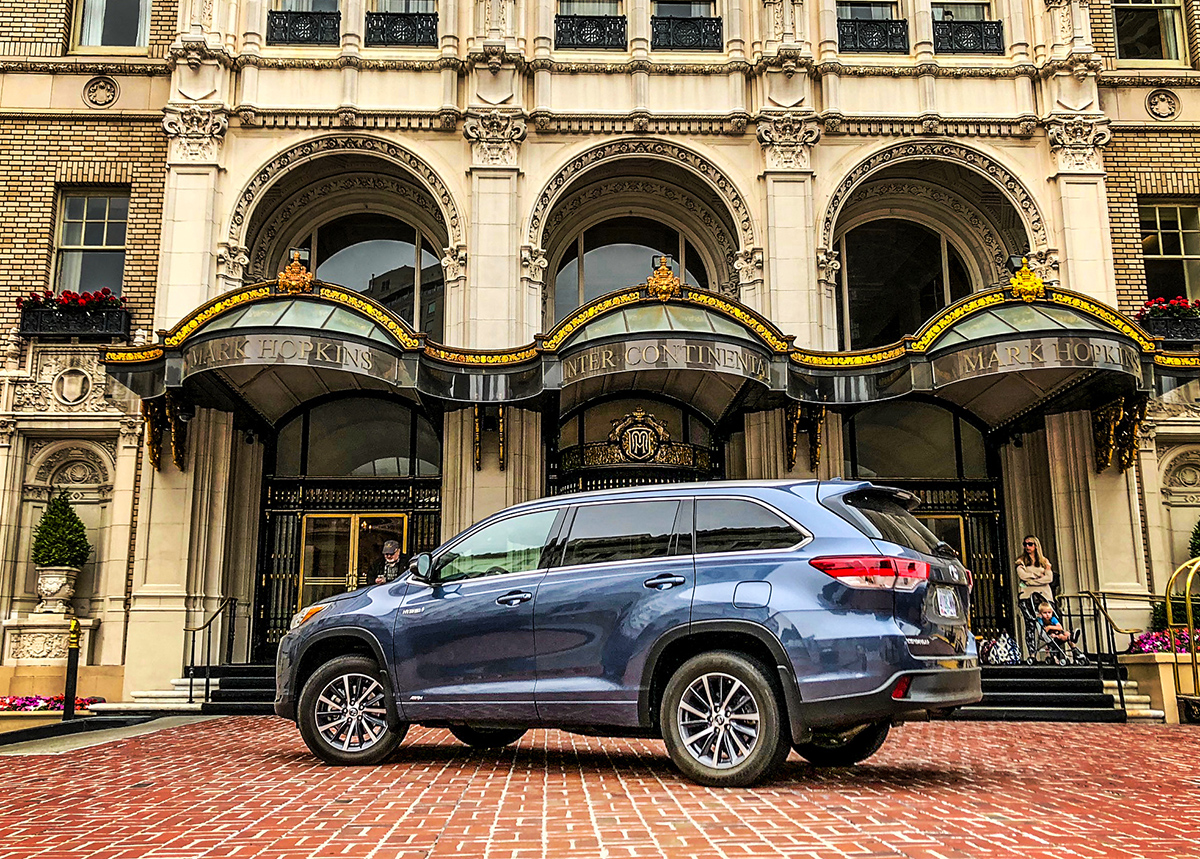
Monday, down to the Mission District for an outstanding Bento Box at Blowfish with another old friend, author and former Grateful Dead publicist Dennis McNally (parking garage just a few blocks away). Then an easy route to Cesar Chavez Blvd. and onto the 101, south to Mountain View where I’d stay and catch my final two shows.
With its proximity (3.8 miles from the venue) individual balconies, and extraordinary breakfast – including made-to-order omelets – the Hotel Zico was, as usual, sold out for the Shoreline shows. Which meant it was a big problem when a pipe opened Sunday night, flooding six rooms and a hallway; but Britta and her crackerjack staff got people relocated, the mellow West Coast Deadheads took it in stride, and soon it was time for the 7:00 PM show.
Or maybe it was too late. Leaving the hotel at 3:00 PM, I cruised up CA-85 at full highway speed, rounded the curve onto US-101 feeling great – and came to a dead stop halfway there. I got to my seat just as the music was starting, about 7:15. In the future, when people complain about traffic on the Beltline in Madison, I’ll tell them to visit San Francisco.
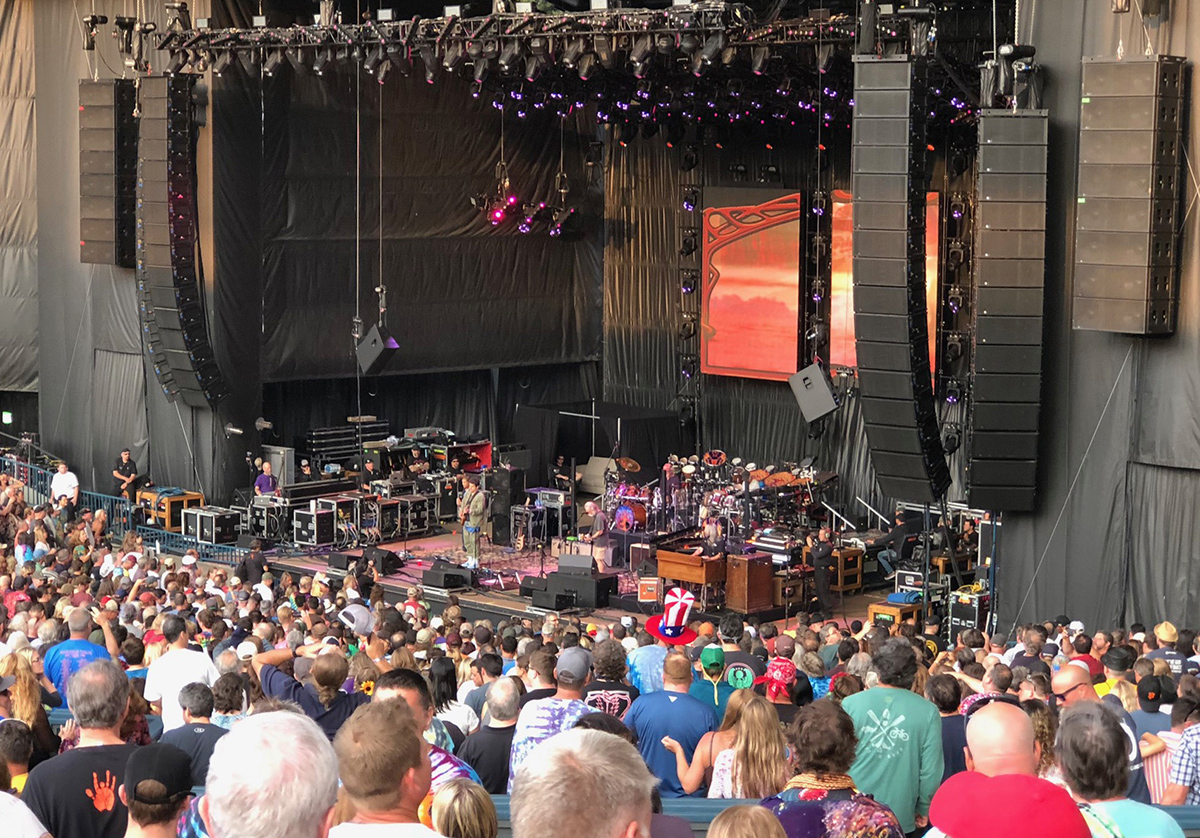
There’s always a little letdown the show after THE show of the tour, which everyone knew Eugene was. But this was a perfectly solid show, with the emotional highlight the emphatic “We will survive!” chorus during the Dead’s 1987 mega-hit, “Touch of Grey.” Indeed, we had, packing sheds from coast to coast.
At least I caught a break getting out. I was sent down a maintenance road and through a parking lot straight onto the 101 by the CHP and back to my quiet patio in time to enjoy a California nightcap – Mamma Chia’s Organic Mango drink (my mother’s favorite fruit) spiked with just a bit of the aforementioned vodka.
Tuesday morning, a final scenic drive to make a meaningful Dead connection. Down the Pacific Coast Highway from Half Moon Bay to San Gregorio, then up the winding, woody CA-84 to La Honda, once home to author (“One Flew Over The Cuckoo’s Nest”) Ken Kesey, who as the organizer of the LSD-fueled Acid Tests in 1965-1967 had a profound impact on the Dead’s early development.
Changing and leaving for the show by 1, I got there and parked without much hassle. That gave me plenty of time to explore and enjoy one of the enduring ancillary aspects of the shows, Shakedown Street, where vendors, hippie and otherwise, sell a vast array of art, clothing, memorabilia, food and beverage.
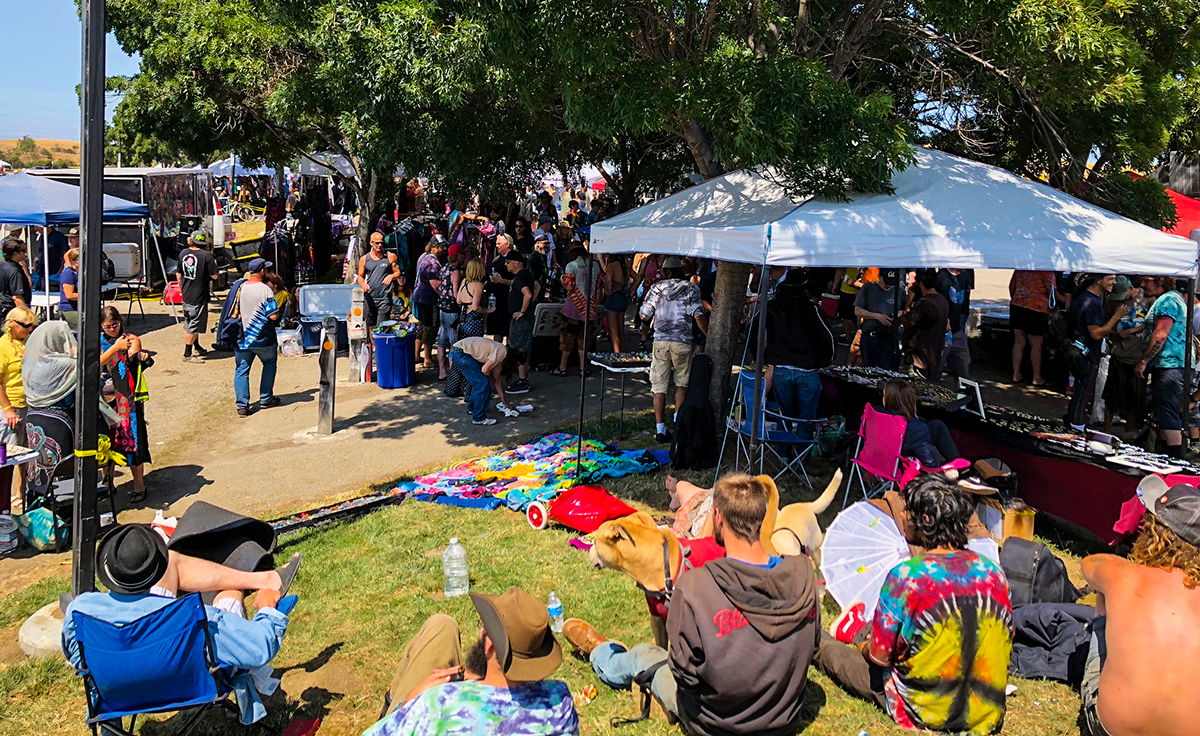
I wasn’t looking to buy anything. I was looking to find Jay and Rebecca, two very interesting people I had met at the Dead & Co. shows at Wrigley Field last summer and saw again at Alpine Valley in June. Sure enough, among the 25,000 or so at the show, I did. It’s nice when things are in synch on tour.
And nice when the synchronicity extends to the band. I’m sure it was because I my wardrobe included a bayou shirt from the New Orleans Jazz and Heritage Festival, and a t-shirt from Tipitinna’s, that they opened with the Crescent City classic, “Aiko-Aiko.” (Yes, some of us do think that way, or at least did when Jerry was alive).
Deadheads refer to the period from Garcia’s birthday (August 1) to his death date (August 8) at “the Days Between.” That’s also the name of the last Hunter-Garcia song, which they wound down the second set with:
And there were days I know
When all we ever wanted
Was to learn and love and grow
Once we grew into our shoes
We told them where to go
Walked halfway around the world
On promise of the glow
Walked upon a mountain top
Walked barefoot in the snow
Gave the best we had to give
How much we’ll never know we’ll never know
After a closing Casey Jones to rock the body – “driving that train, high on cocaine” – they played an encore to soothe the soul – Ripple:
If my words did glow with the gold of sunshine
And my tunes were played on the harp unstrung
Would you hear my voice come through the music
Would you hold it near as it were your own?
It’s a hand-me-down, the thoughts are broken
Perhaps they’re better left unsung
I don’t know, don’t really care
Let there be songs to fill the air
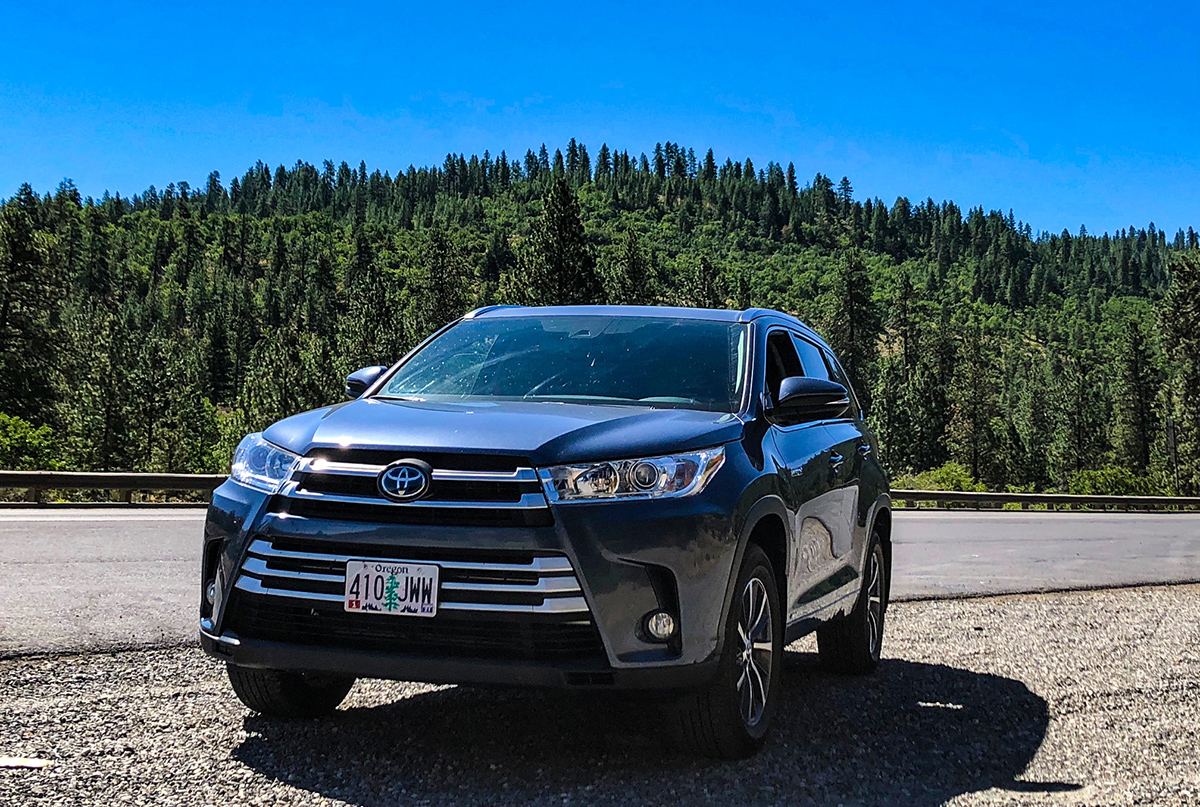
From Seattle to San Francisco (or thereabouts), there were so many songs. And Pearl got me over those 1500 miles safely, in comfort, on time, with reduced emissions and noise. I’m only sorry she didn’t get to hear Dead and Co. play Bird Song. So on the way to the airport to catch an early morning flight home, we listened to a version from 1971 through Bluetooth. It seemed an appropriate way to say goodbye.
2017 Highlander Hybrid
Four-door, eight-passenger, crossover
Base Price: $41,330
Price As Tested: $44,080
Engine: 3.6-liter, 24-valve, direct injected V6
Transmission: 8-speed automatic with manual shifting
Power: 231-hp @ 5,800 rpm
Torque: 215 lbs.-ft. @ 4,800 rpm
Curb weight: 4350 lbs.
EPA MPG: 29 City, 27 highway, 28 Combined

